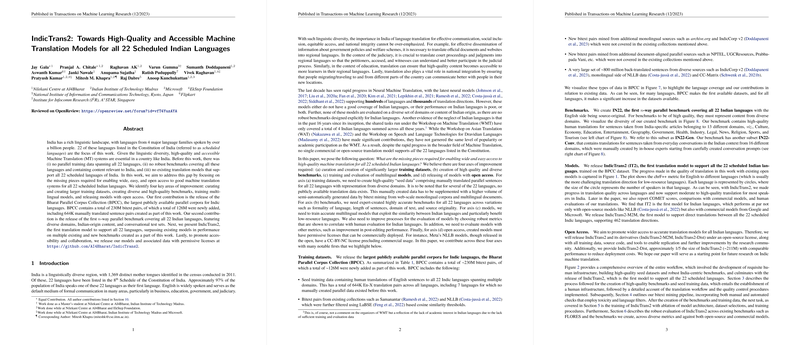High-Quality and Accessible Machine Translation for Scheduled Indian Languages
The paper entitled "IndicTrans2: Towards High-Quality and Accessible Machine Translation Models for all 22 Scheduled Indian Languages" addresses the complex challenge of developing machine translation (MT) systems for the diverse linguistic landscape of India. It focuses on the 22 scheduled Indian languages, aiming to fill significant gaps in data availability, benchmarking, and model support. This work makes notable contributions in four key areas: data creation, benchmarking, model training, and open-access distribution.
Contributions and Highlights
- Data Creation:
- The release of the Bharat Parallel Corpus Collection (BPCC), comprising 230 million bitext pairs, represents the largest publicly available parallel corpora for Indic languages. This includes 126 million newly curated pairs with substantial contributions from mined data and 644,000 manually translated sentence pairs. This corpus addresses prior deficiencies in data availability for several low-resource languages.
- Benchmarking:
- The creation of the IN22 benchmark, an n-way parallel evaluation set, includes test cases for all scheduled languages across varied domains, including conversational formats. This initiative addresses the lack of robust, culturally relevant benchmarks for Indian languages.
- Model Development:
- IndicTrans2, the first translation model to accommodate all 22 languages, shows improved performance over existing models in both En-Indic and Indic-En directions across multiple metrics, including chrF++ and COMET. The models utilize state-of-the-art techniques like back-translation and knowledge distillation to enhance translation quality and model efficiency.
- Open Access:
- The deployment of models and datasets under permissive licenses maximizes accessibility, promoting further research and commercial use. The paper highlights the utility of offering IndicTrans2-Dist, a computationally efficient variant that preserves performance.
Implications and Future Directions
The impact of this research is multifaceted, extending from academic inquiry to practical utility in sectors such as governance, education, and national integration. The work improves language inclusivity in digital technologies, catalyzing socio-economic growth and access to information.
Future research may focus on:
- Enhancing model performance for extremely low-resource languages through innovative data curation techniques.
- Developing more sophisticated, context-aware evaluation metrics tailored for linguistically rich environments.
- Expanding model capabilities to support additional scripts and unscheduled languages, accommodating the evolving linguistic dynamics of India.
By establishing comprehensive benchmarks and publicly accessible resources, IndicTrans2 sets a precedent for the development of inclusive MT systems globally. The paper's methodologies may serve as a blueprint for similar initiatives in other linguistically diverse regions, underscoring its broader significance in the field of machine translation.
